The Intel Core i9-9990XE Review: All 14 Cores at 5.0 GHz
by Dr. Ian Cutress on October 28, 2019 10:00 AM ESTCPU Performance: System Tests
Our System Test section focuses significantly on real-world testing, user experience, with a slight nod to throughput. In this section we cover application loading time, image processing, simple scientific physics, emulation, neural simulation, optimized compute, and 3D model development, with a combination of readily available and custom software. For some of these tests, the bigger suites such as PCMark do cover them (we publish those values in our office section), although multiple perspectives is always beneficial. In all our tests we will explain in-depth what is being tested, and how we are testing.
All of our benchmark results can also be found in our benchmark engine, Bench.
Application Load: GIMP 2.10.4
One of the most important aspects about user experience and workflow is how fast does a system respond. A good test of this is to see how long it takes for an application to load. Most applications these days, when on an SSD, load fairly instantly, however some office tools require asset pre-loading before being available. Most operating systems employ caching as well, so when certain software is loaded repeatedly (web browser, office tools), then can be initialized much quicker.
In our last suite, we tested how long it took to load a large PDF in Adobe Acrobat. Unfortunately this test was a nightmare to program for, and didn’t transfer over to Win10 RS3 easily. In the meantime we discovered an application that can automate this test, and we put it up against GIMP, a popular free open-source online photo editing tool, and the major alternative to Adobe Photoshop. We set it to load a large 50MB design template, and perform the load 10 times with 10 seconds in-between each. Due to caching, the first 3-5 results are often slower than the rest, and time to cache can be inconsistent, we take the average of the last five results to show CPU processing on cached loading.
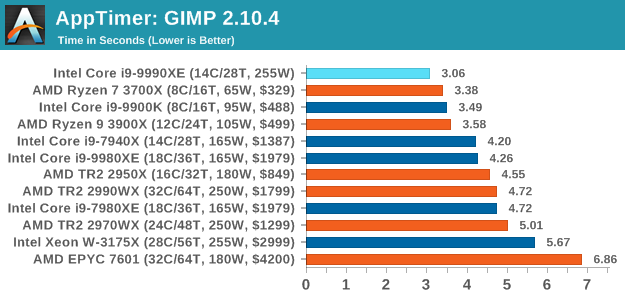
Application loading is a walk in the park for the Core i9-9990XE.
FCAT: Image Processing
The FCAT software was developed to help detect microstuttering, dropped frames, and run frames in graphics benchmarks when two accelerators were paired together to render a scene. Due to game engines and graphics drivers, not all GPU combinations performed ideally, which led to this software fixing colors to each rendered frame and dynamic raw recording of the data using a video capture device.
The FCAT software takes that recorded video, which in our case is 90 seconds of a 1440p run of Rise of the Tomb Raider, and processes that color data into frame time data so the system can plot an ‘observed’ frame rate, and correlate that to the power consumption of the accelerators. This test, by virtue of how quickly it was put together, is single threaded. We run the process and report the time to completion.

FCAT is getting fairly unified across all the processors, with only a few percent separating all the Intel parts.
3D Particle Movement v2.1: Brownian Motion
Our 3DPM test is a custom built benchmark designed to simulate six different particle movement algorithms of points in a 3D space. The algorithms were developed as part of my PhD., and while ultimately perform best on a GPU, provide a good idea on how instruction streams are interpreted by different microarchitectures.
A key part of the algorithms is the random number generation – we use relatively fast generation which ends up implementing dependency chains in the code. The upgrade over the naïve first version of this code solved for false sharing in the caches, a major bottleneck. We are also looking at AVX2 and AVX512 versions of this benchmark for future reviews.
For this test, we run a stock particle set over the six algorithms for 20 seconds apiece, with 10 second pauses, and report the total rate of particle movement, in millions of operations (movements) per second. We have a non-AVX version and an AVX version, with the latter implementing AVX512 and AVX2 where possible.
3DPM v2.1 can be downloaded from our server: 3DPMv2.1.rar (13.0 MB)
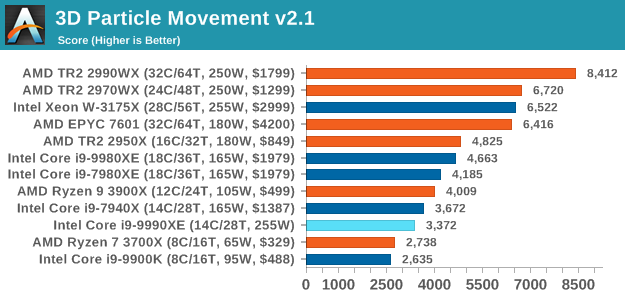
When we run our 3DPM test in a standard mode, the 9990XE again sees a slight regression compared to the 7940X, perhaps indicating that the mesh environment needs some extra MHz.
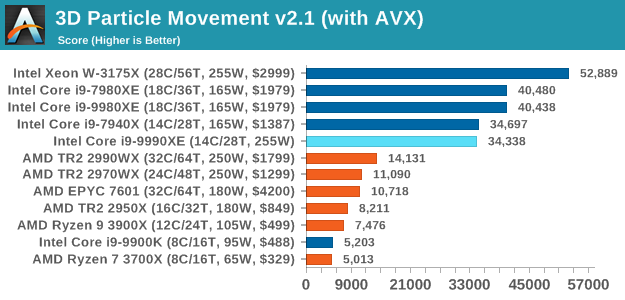
When adding AVX512 into the mix, the 9990XE rises up as with all the other Intel HEDT CPUs, but still can only match the slower 7940X despite having the same number of cores. At this point we're more core limited than frequency limited, indicating that there are some pipeline stalls in this test.
Dolphin 5.0: Console Emulation
One of the popular requested tests in our suite is to do with console emulation. Being able to pick up a game from an older system and run it as expected depends on the overhead of the emulator: it takes a significantly more powerful x86 system to be able to accurately emulate an older non-x86 console, especially if code for that console was made to abuse certain physical bugs in the hardware.
For our test, we use the popular Dolphin emulation software, and run a compute project through it to determine how close to a standard console system our processors can emulate. In this test, a Nintendo Wii would take around 1050 seconds.
The latest version of Dolphin can be downloaded from https://dolphin-emu.org/
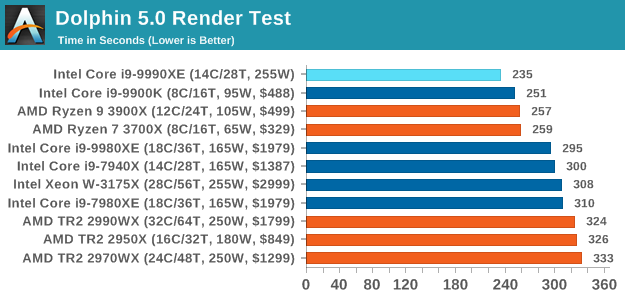
Dolphin is a heavily single threaded test, so we see the highest frequency from Intel and AMD at the top here.
DigiCortex 1.20: Sea Slug Brain Simulation
This benchmark was originally designed for simulation and visualization of neuron and synapse activity, as is commonly found in the brain. The software comes with a variety of benchmark modes, and we take the small benchmark which runs a 32k neuron / 1.8B synapse simulation, equivalent to a Sea Slug.

Example of a 2.1B neuron simulation
We report the results as the ability to simulate the data as a fraction of real-time, so anything above a ‘one’ is suitable for real-time work. Out of the two modes, a ‘non-firing’ mode which is DRAM heavy and a ‘firing’ mode which has CPU work, we choose the latter. Despite this, the benchmark is still affected by DRAM speed a fair amount.
DigiCortex can be downloaded from http://www.digicortex.net/
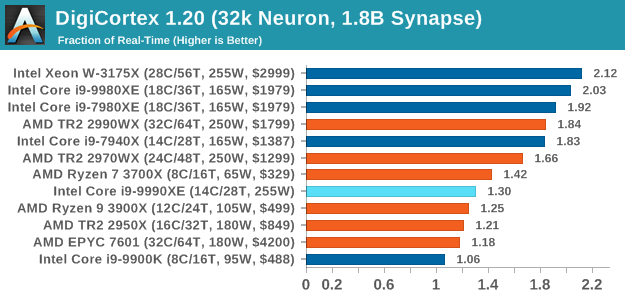
DigiCortex likes memory frequency and internal speeds more than raw core frequency, and again the 9990XE doesn't perform too well here.
y-Cruncher v0.7.6: Microarchitecture Optimized Compute
I’ve known about y-Cruncher for a while, as a tool to help compute various mathematical constants, but it wasn’t until I began talking with its developer, Alex Yee, a researcher from NWU and now software optimization developer, that I realized that he has optimized the software like crazy to get the best performance. Naturally, any simulation that can take 20+ days can benefit from a 1% performance increase! Alex started y-cruncher as a high-school project, but it is now at a state where Alex is keeping it up to date to take advantage of the latest instruction sets before they are even made available in hardware.
For our test we run y-cruncher v0.7.6 through all the different optimized variants of the binary, single threaded and multi-threaded, including the AVX-512 optimized binaries. The test is to calculate 250m digits of Pi, and we use the single threaded and multi-threaded versions of this test.
Users can download y-cruncher from Alex’s website: http://www.numberworld.org/y-cruncher/
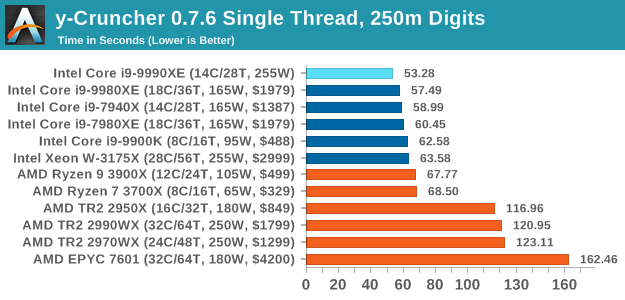
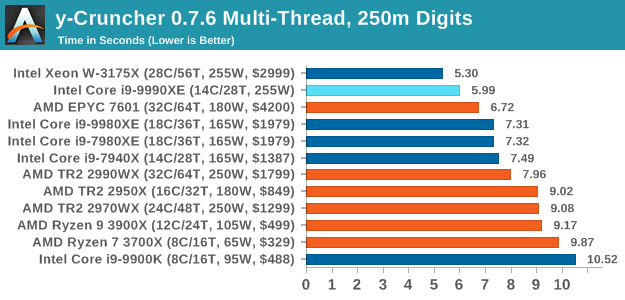
y-Cruncher is an AVX-512 accelerated test, and with the high frequency it gets the top score in our ST test.
Agisoft Photoscan 1.3.3: 2D Image to 3D Model Conversion
One of the ISVs that we have worked with for a number of years is Agisoft, who develop software called PhotoScan that transforms a number of 2D images into a 3D model. This is an important tool in model development and archiving, and relies on a number of single threaded and multi-threaded algorithms to go from one side of the computation to the other.
In our test, we take v1.3.3 of the software with a good sized data set of 84 x 18 megapixel photos and push it through a reasonably fast variant of the algorithms, but is still more stringent than our 2017 test. We report the total time to complete the process.
Agisoft’s Photoscan website can be found here: http://www.agisoft.com/
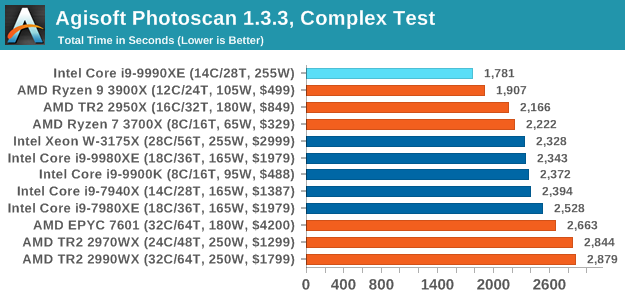
Agisoft is a variable threaded workload, and it seems the Core i9-9990XE has the best combination of cores and threads.












145 Comments
View All Comments
yannigr2 - Monday, October 28, 2019 - link
An over 300W chip that loses in so many cases from chips that cost under $500, with less than half power consumption. And Intel is $auctioning$ it. That isn't even funny. It's tragic.AshlayW - Monday, October 28, 2019 - link
600W for performance that's not even going to be that much over a 3950X (if at all?) Intel is a laughing stock at this point. Can't wait to see the 9900KS, and have a good laugh at the last desperate, dying twitches of the Skylake architecture.29a - Monday, October 28, 2019 - link
HFT should be illegal!MrSpadge - Monday, October 28, 2019 - link
Why? And on which basis would you forbid it? I think the better way to deal with this is to attach a tiny tax to each transaction. So if it's really worth it, they may do it. But the government gets its share and can redistribute to something more useful.RBFL - Monday, October 28, 2019 - link
It has no useful purpose for society, the fact it is difficult to identify the people being harmed does not mean that harm is not taking place.I think making people have a 1 second relationship with a share is not unreasonable. Just because someone can do something doesn't mean we have to allow it. We have speed limits, laws against dishonesty and murder and we could just as easily have one against HFT.
The fact that exchanges sell expensive server space to these companies for lower pings, while purportedly being the arbiters of fair play and price transparency is, of course, another big issue.
rahvin - Monday, October 28, 2019 - link
So anything you in your all knowing capacity deem as not useful for society at large it should be illegal? Doesn't that mean gaming should be illegal?I've yet to meet a single one of these people that complain about HFT that actually understand how the market works, how stock trading function and what HFT even is. Most of them simply heard some talking point they regurgitate without any understanding of how the stock market even works let alone how a stock transaction works or what HFT involves.
shadowx360 - Monday, October 28, 2019 - link
It's a mix of ignorance and jealousy, that they can't be the successful ones rolling in dough, and all investing is somehow evil and taking advantage of the common worker. There are some downsides to HFT, namely increased market volatility and cascading problems where a fall in prices can trigger millions of stop losses that compound the issue, but like you said, most have zero clue.RBFL - Tuesday, October 29, 2019 - link
And that statement is based on?I am not jealous of an industry that has basically bought its way to success through lobbying and every time it explodes it expects the rest of us to reboot it, while mysteriously keeping the proceeds prior to the crash. An industry that gives away billions of our dollars of our money to avoid their own prosecution. Where almost no-one goes to jail after egregious lies, fraud, money laundering,....
All investing is not evil, however many of the practices of the industry are. Lobbying against fiduciary duty for the small investor, for example. If you actually look at the share classes available you will undoubtedly see some that no-one who understood what they were being sold would ever buy. Telling people 'they are responsible for their future' while not cleaning up the industry is like throwing sheep to wolves. And no, it is not everyone's responsibility to know every evil practice in every area of life in which they are forced to deal. It is unrealistic for the well educated, let alone the average citizen. It is why we have laws, which are generally reactive rather than proactive and thus mainly address known abuses rather prospective ones.
Alistair - Monday, October 28, 2019 - link
Nice article, except the final page. Why mention "highest ST for HEDT" and "carves through AMD like butter" etc., then you don't even make mention of any MT performance in summary. You could have said, in MT scenarios, it performs about the same as any Intel 18 or AMD 24 core server CPU or some such.Alistair - Monday, October 28, 2019 - link
my meaning is the summary shouldn't just be for what is awesome, but should also summarize all the results... no mention of multi threading performance on the final page at all, because it isn't special?